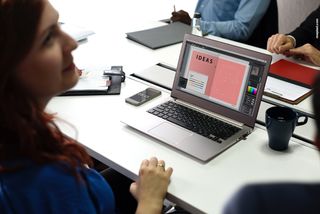Fresh ideas for building websites
Why you should look beyond website project boundaries.

Think back to your latest digital project. It probably came about because something old had problems, or someone identified an opportunity to do something better. Almost all of our projects (excluding those for learning or fun) are borne out of a desire to improve. We want to make websites faster and more secure, with a UI design that makes them easier to use and great to look at.
- Christmas offer: Save up to 47% on a subscription to net magazine
The rate of change of technology available to us means there’s always something we can be tweaking to take advantage of the latest spec, API or library. Nothing stands still. Everything moves and we, as people who work with the web, move with it.
Why you should think broader
My career is a good example. Starting out as a back-end developer, I got more and more interested in ‘whys’ and my work shifted towards discovery and strategy. I started caring more about the people using websites hand-in-hand with learning more about technology; letting users influence solutions.
It often doesn't matter how good your design or code is – other factors can have a big impact on the success of projects.
As a developer, I was always asking questions. Did the site need to be multilingual? Would a CDN help us better serve them? How would people be searching, so I could structure data accordingly? All of these questions came from wanting to make sure I was making the best possible websites, yet my thinking was starting and finishing with the website itself.
That all changed when I began to work for myself a few years ago, and the projects that I was working on shifted slightly. Rather than websites being the beginning and end point, I realised that looking at everything else around them could also make a huge difference.
It often doesn't matter how good your design or code is – other factors can have a big impact on the success of projects.

The space I now work in is best described as ‘digital transformation’, which is a phrase I have a love/hate relationship with due to its buzzword-tastic usage. For me, my work is all about positive change; about using digital technologies to make things better, as well as about helping people to be able to work better with technology.
Get the Creative Bloq Newsletter
Daily design news, reviews, how-tos and more, as picked by the editors.
By looking more broadly than just immediate concerns, we can not only remove some of the repeated problems we may face when making websites and putting them into the wild, but we can also use our digital skills to make the world a better place in general.
Here are a few examples of situations where there's a good chance for positive change to happen:
- The brief was to create a beautiful set of new pages and patterns to replace an old, failing site, but the existing CMS continued to spew out inaccessible markup, and was also really awkward to use, so content never got updated. The website therefore failed.
- A highly experienced lead developer is always a big advocate of performance, but because senior management slashed their project time in half, they have to cut corners.
- Lots of different systems and technologies are used through a lack of strategy. The development and ops teams are finding it hard to support them all.
- Old, paper-based processes are taking up staff time and introducing manual errors.
- Data is locked away in elaborate databases, and the insight available from it isn't being used by non-technical people who could benefit.
When you start to look into the root causes of why websites or digital projects may suffer the same issues, or identify other areas that could be better, you'll likely discover that findings fall into the following areas: technology, processes, people/culture, and strategy.
Other factors that can affect your web projects
Technology
Where technology isn't yet in place and maybe should be, you might have issues around inefficiencies or inaccuracy. However, when poor choices are made, other problems may occur. Are you making technology choices based on personal developer convenience and preference, or are there impacts on your users, the rest of your business, or your teammates?
Thinking about the future, scalability, extensibility and the ability to react are all important, and should be part of the decision-making process. By updating the way we approach technology selection, we can try to make sure that our products are given the best chance, and our teams kept happy.
Processes
When we start to peel back the layers of everything that lies around our websites, we can often find manual or tedious processes that can be improved. This goes for our own project workflows as well as customer journeys, or back-office tasks.
Trying to find ancillary processes we can update can provide us with new opportunities to make people's lives easier, do things more quickly, or change older ways of thinking. Many process points that get taken at face value are worth questioning, as their importance may be being overstated, and could be prime opportunities for radical change.

People and culture
The people involved in a website aren't just our end-users – they're our customers, but they're also those people making our sites, updating them, the business stakeholders who need to get information out of them, and the managers influencing the process. It's everyone who's involved or who will be.
Are our teams structured well with all of the roles we need? Do they have the right skills and training? Is the culture right for everyone to work well, and are they happy? Is everyone pulling in the same direction? If we have the right mix, the culture they work in is as good as possible, and if everyone has the skills, knowledge and support that they need, then our projects will be much better.
Strategy
Underlying much of this is strategy itself – what the plan is for digital, how teams will evolve, which areas are a priority for change, and how technology selections are made.
Strong leadership, an ability to embrace change and try new things, and the ability to trust experts within a team can all play a valuable role. When the strategy, leadership and direction are good, the above areas are more likely to be working more seamlessly.
What's beyond websites
As time and technology have moved on, I've watched the ebb and flow of different technologies with interest and with some awe – we can do incredible things with the web now that I'd never have thought possible when I started out.
Consider thinking beyond users, into people who build sites, those behind the scenes, and everything else feeding in
It's only getting more exciting: the current fixation with AI and machine learning, VR, interfaces beyond screens, and the Internet of Things movement grant us a lot of possibilities – not only for our customers but also for our own work practices.
The technology available to us progresses every day, and coupled with that, as an industry, I think we've mostly become fantastic at thinking about how it impacts on users.
We can work to make our websites better – turning those checks green for performance, passing accessibility testing with flying colours, or using newer concepts like PWAs to save people both data and exacerbation on trains.
Next project, however, consider thinking beyond users, into people who build sites, those behind the scenes, and everything else feeding in. Look more widely to find areas you can change for the better with digital skills – whether that's teaching those around you, looking for processes to update, or viewing technology through different lenses to make a selection that works for everyone.
Let's reclaim digital transformation from buzzword bingo and instead use it as an aspiration – making positive change happen beyond the confines of our website boundaries and browser chrome.
Illustration: By Kym Winters
This article originally appeared in issue 297 of net, the magazine for professional web designers and developers – offering the latest new web trends, technologies and techniques. Buy issue 297 here or subscribe to net here.
Special Christmas offer: Save up to 47% on a subscription to net magazine for you or a friend for Christmas. It's a limited offer, so move quickly...
Related articles:

Thank you for reading 5 articles this month* Join now for unlimited access
Enjoy your first month for just £1 / $1 / €1
*Read 5 free articles per month without a subscription

Join now for unlimited access
Try first month for just £1 / $1 / €1
